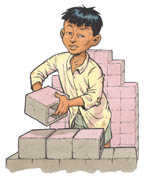Reference Texts
Where are Children Exploited?

Return to Reference Texts

The International Labour Office estimates that more than 250 million children work currently around the world, of which 61% are in Asia, 32% in Africa, and 7% in Latin America. Although this practice is less common in North America, children are not immune to such practices.
In Canada, child labour exists as well in areas such as newspaper delivery, bagging groceries, cooking, and working tills. The practice is frequent in rural Quebec where youth less than 14 years of age are paid less than minimum wage. For example, youth under 14 account for close to half of the 600 workers in the strawberry fields of the Lanaudière region. The sale of chocolate also employs thousands of youth, giving them a dollar or so for every bar sold going door to door. Some companies promise a minimum of $100 a day of profit.
In Latin America, 17.5 million children work to survive, of which 60% are found agriculture. Beyond family farms, however, large agricultural operations also utilise child labour. Throughout the continent one can find children working on plantations growing sugar, coffee, tobacco, and rubber. According to the International Labour Office, the structured economic sector doesn’t employ more than 10% of working children. These children are found on construction sites and brickyards, and in the manufacturing industry, which like agriculture is largely dedicated to producing products for export.
- In the Dominican Republic, many young agricultural workers are imported from Haiti.
- In Colombia, between 800,000 and 3 million child labourers work in domains such as the flower export industry that was developed in the nineties. Coal mines, many of which are not officially approved and therefore unlicensed, employ children between the ages of 7 and 10 years. These children, referred to as “mole children”, crawl in narrow and poorly lit mine shafts, often without helmets nor personal protection equipment, in exhausting conditions.
- Estimates state that between 7 and 12 million child labourers can be found in Brazil, of which 3 million work in agriculture. Sugar cane plantations employ approximately 60,000, which constitutes a quarter of the sector’s employees. Children are also employed to operate wood kilns, and are often subjected to 12 hour work days under armed surveillance. Children caught trying to escape are often violently reprimanded, which can even lead to death. Thousands of children are employed in shoe production in small workshops around Sao Paulo, and children working under armed surveillance have also been found in a brewery in the state of Mato Grosso do Sul. Nine thousand children also work around Santa Cruz in the growing of sisal, a fiber used to make rope and twine.
- In Haiti, 200,000 domestic workers, of which three-quarters are girls, often work as many as 18 hours a day. The phenomena of “restaveks” has increased with colonisation. Social inequality and poverty have led poorer families to offer their children to financially wealthy, urban families. They hope for a better life for their children, but to the host families, the “restaveks” have little importance. They are often beaten and excluded from the family, and often are not allowed to eat the same food. Estimates state that one of every five Haitian domestic workers suffer poor treatment, including sexual abuse.
Africa is the continent most affected by this phenomena, with approximately 40% of children working, equal to 80 million children according to the International Labour Office. Most of this work is for family subsistence, and 37% of young girls perform domestic work, the highest proportion in the world. Additionally, many rural youth move to the cities where the informal work sector is well developed. They go to earn money for their families, and occupy many roles such as shoe polishers and peddlers.
- According to UNICEF, Kenya is home to 200,000 domestic child labourers, and Benin 400,000. Another 100,000 young children from Benin work domestically in Nigeria, and children from Mali and Benin also work in Cote-d’Ivoire and Gabon.
- Twelve million children work in Nigeria, the most populated country in Africa. The trading of children as slaves is also present.
- In South Africa, there are 400,000 child labourers, several thousand of which work in orchards.
- In 1993, the capital of Senegal housed 88,000 domestic child labourers. The average family has six children that are considered an essential service to complete household chores. Work hours are long, tasks are demanding, and children work six or seven days a week. Contracts for domestic workers are extremely rare, and employers may fire the children at the slightest error or for such events as a pregnancy.

|